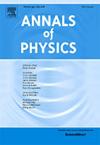具有常规和量子化度量张量的真空齐次和非齐次度量:奇异或非奇异解
IF 3
3区 物理与天体物理
Q2 PHYSICS, MULTIDISCIPLINARY
引用次数: 0
摘要
为了研究宇宙是否经历了奇点或保持了非奇点状态,我们在齐次和非齐次宇宙背景下对真空中Raychaudhuri方程的演化进行了解析和数值分析。系统地比较了Schwarzschild、friedman - lema本文章由计算机程序翻译,如有差异,请以英文原文为准。
Vacuum homogeneous and nonhomogeneous metrics with conventional and quantized metric tensor: Singular or nonsingular solution
To investigate whether the Universe underwent a singularity or maintained a nonsingular state, we carry out analytical and numerical analyses of the evolution of the Raychaudhuri equations in vacuum, alongside homogeneous and nonhomogeneous cosmic backgrounds. The results obtained from the Schwarzschild, Friedmann–Lemaître–Robertson–Walker (FLRW), and Einstein–Gilbert–Straus (EGS) metrics are systematically compared. Analyzing the results from both, conventional and quantized metric tensor, it revealed insights into the nature of initial and spatial singularities. Results associated with the Schwarzschild metric demonstrate a positive evolution that corresponds with a reduction in radial distance (nonsingularity). In contrast, the proposed quantization reverses this trend, leading to a negative evolution (singularity). The situation is similar for the FLRW metric, where the suggested quantization results in a positive evolution as cosmic time decreases, in contrast to the classical and hybrid metrics, which are associated with negative evolution. The analysis of the EGS metric reveals that classical evolution remains positively oriented, particularly with a reduction in radial distance. Moreover, the introduction of quantized and hybrid metric tensors fully retrains the cosmic time dependence. The results obtained are a rightful recognition of the substantial efforts dedicated to the establishment of the Swiss-cheese model, demonstrating that the EGS metric indeed facilitates the temporal and spatial development of our Universe.
求助全文
通过发布文献求助,成功后即可免费获取论文全文。
去求助
来源期刊

Annals of Physics
物理-物理:综合
CiteScore
5.30
自引率
3.30%
发文量
211
审稿时长
47 days
期刊介绍:
Annals of Physics presents original work in all areas of basic theoretic physics research. Ideas are developed and fully explored, and thorough treatment is given to first principles and ultimate applications. Annals of Physics emphasizes clarity and intelligibility in the articles it publishes, thus making them as accessible as possible. Readers familiar with recent developments in the field are provided with sufficient detail and background to follow the arguments and understand their significance.
The Editors of the journal cover all fields of theoretical physics. Articles published in the journal are typically longer than 20 pages.
 求助内容:
求助内容: 应助结果提醒方式:
应助结果提醒方式:


